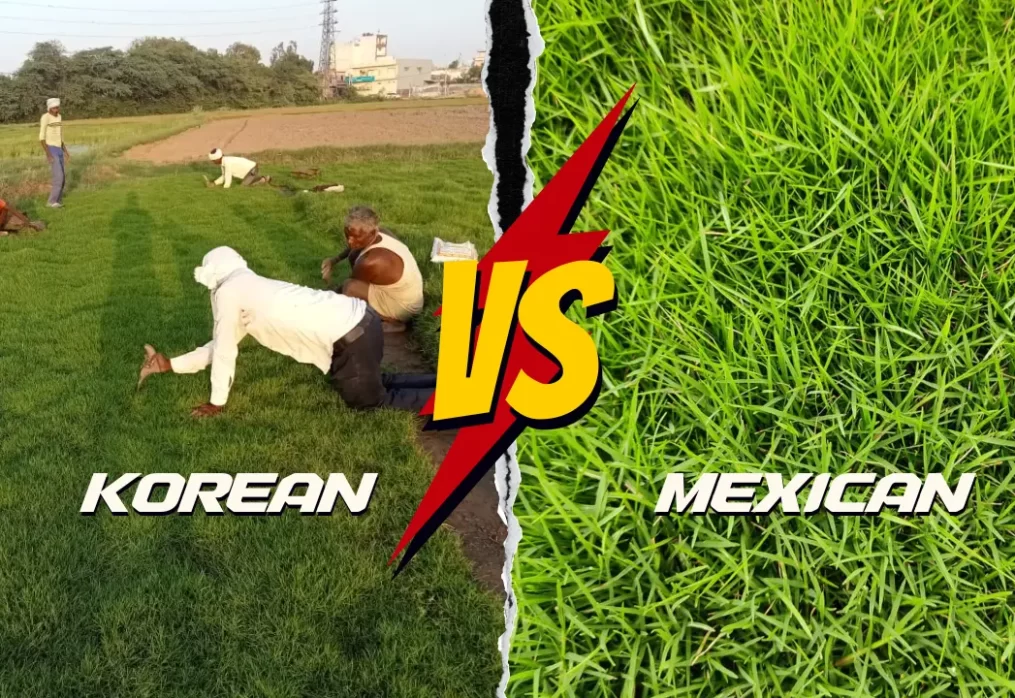Korean Grass vs Mexican Grass – Which Suits Indian Climate?
Introduction
Choosing the right lawn grass in India isn’t just about looks—it’s about practicality, climate adaptability, and long-term care. Among the popular options, Korean grass and Mexican grass stand out. But which one suits Indian climate better? Let’s break it down in detail so you can make the right decision for your lawn.
Understanding Korean Grass
Botanical name and origin: Korean grass, also known as Zoysia tenuifolia, is native to Southeast Asia.
Growth habits and features: This grass grows slowly but forms a dense, carpet-like cover. It is known for its soft, cushiony texture.
Appearance and texture: Korean grass has fine blades, lush green color, and gives a velvety feel, making it a premium choice for ornamental lawns.
Understanding Mexican Grass
Botanical name and origin: Mexican grass (Pennisetum clandestinum) is native to tropical regions.
Growth habits and features: This grass grows faster than Korean grass and spreads aggressively, covering large areas quickly.
Appearance and texture: Mexican grass is slightly coarse, with wider blades. It doesn’t look as soft as Korean grass but is more durable.
👉 If you are considering Mexican Grass, explore our Mexican Grass to learn about its dense coverage, cost-effectiveness, fast spreading nature, and suitability for sunny outdoor areas.
Korean Grass vs Mexican Grass: Key Differences
- Growth speed: Korean grass grows slowly, while Mexican grass grows rapidly.
- Leaf structure: Korean grass has fine, soft blades; Mexican grass has wider and coarser blades.
- Shade tolerance: Korean grass tolerates partial shade better; Mexican grass prefers open sunlight.
- Durability: Mexican grass is more resistant to heavy use, while Korean grass is delicate under constant foot traffic.
👉 Want to know more about Korean Grass in detail? Check out our Korean Grass where we cover its growth pattern, maintenance needs, durability, and why it is a preferred choice for shaded lawns and low-maintenance gardens.
Climate Suitability in India
- Korean grass: Performs well in moderate climates with partial shade, suitable for landscaped gardens in Delhi, Bangalore, and hill stations.
- Mexican grass: Thrives in hot and dry regions like Rajasthan, Gujarat, and Telangana. Perfect for areas with full sun exposure.
- Regional breakdown:
- North India: Korean grass for shaded gardens, Mexican grass for sunny lawns.
- South India: Mexican grass adapts better to heat.
- East India: Korean grass handles humidity well.
- West India: Mexican grass is ideal for drought-prone areas.
Soil Requirements
- Korean grass: Prefers fertile, well-drained soil rich in organic matter.
- Mexican grass: Adapts to various soil types, even poor soils with less care.
Water Requirements
- Korean grass: Needs regular watering, especially in dry seasons.
- Mexican grass: More drought-tolerant, can survive with less frequent watering.
Maintenance Needs
- Korean grass: Requires less mowing due to slow growth but needs regular care to maintain its premium look.
- Mexican grass: Needs frequent mowing due to fast growth, but overall, it is tougher and low-maintenance.
Cost Factor
- Initial installation: Korean grass is costlier per square foot due to its premium appeal.
- Mexican grass: More affordable and widely available.
- Long-term cost: Korean grass requires more care, while Mexican grass saves money in maintenance.
Aesthetic Appeal
- Korean grass: Perfect for a luxury garden look; soft, lush, and elegant.
- Mexican grass: Offers a simple, green cover but lacks the premium velvet-like texture.
Best Uses
- Korean grass: Ideal for ornamental gardens, resorts, and homes where appearance matters more than durability.
- Mexican grass: Best for playgrounds, parks, and high-traffic areas where strength is needed.
Pros and Cons of Korean Grass
Pros:
- Elegant, lush, and soft look
- Tolerates partial shade
- Low mowing frequency
Cons:
- Slow growth
- Costly
- Not durable under heavy foot traffic
Pros and Cons of Mexican Grass
Pros:
- Fast-growing and spreads quickly
- Affordable
- Highly durable under traffic
- Drought-resistant
Cons:
- Requires frequent mowing
- Coarse texture
- Doesn’t thrive well in shade
Expert Recommendations
- For homeowners: If you want a stylish, ornamental lawn and are willing to invest time and care, Korean grass is your best choice.
- For public spaces: If durability and affordability matter most, Mexican grass is the winner.
Conclusion
Both Korean grass and Mexican grass have their own charm and strengths. If you live in a hot, dry region, Mexican grass will serve you better. But if you want a luxury-looking ornamental garden and don’t mind investing in care, Korean grass is perfect. The final choice depends on your climate, budget, and lawn purpose.
FAQs
1. Which grass grows faster in Indian conditions?
Mexican grass grows much faster compared to Korean grass.
2. Is Korean grass suitable for low-maintenance lawns?
Not really. Korean grass needs consistent care to look premium, though it grows slowly.
3. Can Mexican grass survive in shady areas?
Mexican grass struggles in shade and grows best in full sunlight.
4. Which grass is more durable for kids and pets?
Mexican grass is stronger and better suited for high activity.
5. Which grass is budget-friendly in the long run?
Mexican grass is more affordable both initially and in long-term care.
Last Updated on 3 months ago by Anjali Mehra Ph.D. in Horticulture (Punjab Agricultural University)
- Grass Types that Survive Frost & Snow (Uttarakhand-Specific) - December 6, 2025
- Low-Water Grass Varieties for Hilly Homes in Uttarakhand - December 1, 2025
- Mexican Grass vs Bermuda Grass – Which is Best for Indian Lawns? - November 28, 2025
